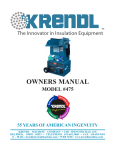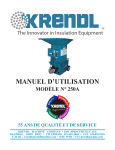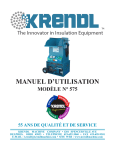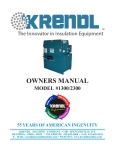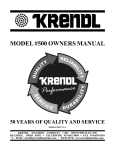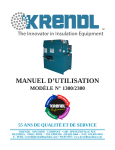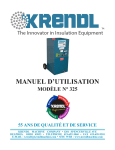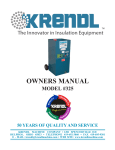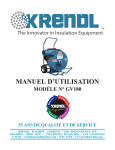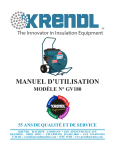Download Sharp R-408J Owner`s manual
Transcript
OWNERS MANUAL MODEL #425 55 YEARS OF AMERICAN INGENUITY KRENDL MACHINE COMPANY • 1201 SPENCERVILLE AVE DELPHOS, OHIO 45833 • TELEPHONE 419-692-3060 • FAX 419-695-9301 E - MAIL: [email protected] • WEB SITE: www.krendlmachine.com CONGRATULATIONS ON YOUR PURCHASE OF KRENDL EQUIPMENT MODEL #425 OWNER'S MANUAL FOR ASSURED SAFETY AND CONFIDENCE, PLEASE READ THIS MANUAL CAREFULLY BEFORE INSTALLING AND OPERATING YOUR MACHINE. E-MAIL ADDRESS IS: [email protected] WEB SITE IS: www.krendlmachine.com Table of Contents PAGE INTRODUCTION. . . . . . . . . . . . . . . . . . . . . . . . . . . . . . . . . 1 GENERAL SAFETY INFORMATION. . . . . . . . . . . . . . . . . . 2-3 DECALS . . . . . . . . . . . . . . . . . . . . . . . . . . . . . . . . . . . . . . 4-5 WARRANTY . . . . . . . . . . . . . . . . . . . . . . . . . . . . . . . . . . . . 6 RETURNED GOODS PROCEDURE and SPECIFICATIONS 7 BASIC COMPONENTS. . . . . . . . . . . . . . . . . . . . . . . . . . . . 8 OPERATING INSTRUCTIONS . . . . . . . . . . . . . . . . . . . . . . 9-11 TROUBLESHOOTING . . . . . . . . . . . . . . . . . . . . . . . . . . . . 12 GENERAL MAINTENANCE . . . . . . . . . . . . . . . . . . . . . . . . . 13-15 ELECTRICAL . . . . . . . . . . . . . . . . . . . . . . . . . . . . . . . . . . . 16 LADDER DIAGRAM . . . . . . . . . . . . . . . . . . . . . . . . . . . . . . 17 PARTS LIST . . . . . . . . . . . . . . . . . . . . . . . . . . . . . . . . . . . . 18-21 GLOSSARY . . . . . . . . . . . . . . . . . . . . . . . . . . . . . . . . . . . . 22 SERVICE RECORD. . . . . . . . . . . . . . . . . . . . . . . . . . . . . . 23 MODEL #425 INTRODUCTION Thank you for purchasing a KRENDL INSULATION MOVING MACHINE. With over fifty-five years experience in manufacturing insulation moving equipment, we have designed and built your machine with the highest quality to provide years of reliable service. This manual has been prepared to help you obtain the maximum efficiency and service from your Krendl equipment. The machine is designed to condition and apply insulation with the utmost in dependable performance. Our primary objective is to build equipment which will provide complete satisfaction so that you may confidently recommend Krendl to others. We do not manufacture or sell insulation. Our interest lies only in the proper performance of the equipment we manufacture. We make no recommendations or guarantees concerning various insulations. CAUTION: This manual contains important information regarding the safe assembly and operation of your machine. We urge you to read it carefully and follow the instructions provided. If your questions are not answered in this manual, may we hear from you? We want you to be able to operate this unit safely and confidently. UNPACKING: Store and unpack carton with correct side up. Unpack your machine IMMEDIATELY and check for damage in shipping. Place any damage claim with delivering carrier, saving all packing materials for inspection. Our warranty covers manufacturer's defects only. DO NOT return to shipper. FILL IN AND RETAIN: Krendl Machine Company 1201 Spencerville Ave. Delphos, Ohio 45833 U.S.A. Telephone: Fax: E-mail: Web Site: 419-692-3060 419-695-9301 [email protected] www.krendlmachine.com For your protection in the event of theft or loss, please fill in the information requested for your own records. This information will be needed for in-warranty repairs. You may also want to attach a copy of your invoice. Machine model number_____________ Blower motor manufacturer _ Serial number Gear motor manufacturer _ _ Blower(s) serial number(s)___________ Gear motor serial number________________________ Supplier_________________________ Date of purchase ______________ The model and machine serial numbers are located on the hopper of the machine unit. The blower and gearmotor serial numbers are located on the motor housing of each unit. Rev. Date: 12-15-14 Page 1 MODEL #425 GENERAL SAFETY INFORMATION Important: Read all instructions before operating this unit. This equipment can be potentially dangerous and must be used in strict accordance with instructions. Disclaimer Notice: The manufacturer will not be legally responsible for any injury or damage resulting from the improper use of this equipment or the failure to follow instructions. Unpacking Handle cartons with care to avoid damage from dropping or bumping. Store and unpack cartons with the correct side up. Completely remove machine from the packaging and from any shipping pallet or skid to which it might be attached. In addition, completely remove all shipping materials from inside the machine including wheel package, manual, ect.... General Safety 1. Read this manual carefully and become familiar with your machine unit. Know its applications, limitations, and any hazards involved. 2. This machine was designed and manufactured for specific applications. Do not attempt to modify the unit or use it for any application it was not designed for. If you have any questions about your intended use or the machines suitability, ask your dealer/distributor or consult the factory. The manufacturers' could not possibly anticipate every circumstance that might involve a hazard. For that reason, warnings in the manual and warning tags or decals affixed to the unit, are not all-inclusive. If you intend to handle, operate, or service the unit by a procedure or method not specifically recommended by the manufacturer, first make sure that such a procedure or method will not render this equipment unsafe or pose a threat to you and others. Electrical Safety • The National Electric Code (NEC) in the United States and many international electrical codes require frame and external electrically conductive parts of this machine to be properly connected to an approved earth ground. Local electrical codes may also require proper grounding of machine. Consult with local electricians for grounding requirements in your area. • Never handle any kind of electrical cord or device while standing in water, while barefoot or while hands or feet are wet. Dangerous electrical shock will result. • Use a ground fault circuit interrupter (GFCI) in any damp or highly conductive area. (metal decking or steel work) • Reference NFPA 79, 70E, or OSHA safe work practices when performing energized work procedures. Rev. Date: 12-15-14 Page 2 MODEL #425 Safety/Caution • Be Safe - Keep away from moving parts. • Be Safe - Make sure all guards and hopper bar are in proper place before operating machine. Guards and safety devices/switches should not be removed, modified or by-passed. Hands should never pass below hopper bar. • Be Safe - Do not remove motors or lift hopper when unit is connected to power supply. • Be Safe - Make sure machine is properly grounded. Protect all electrical supply cords from sharp objects, moisture, and other potentially hazardous materials. Keep power cords in good repair. Electrical service must be performed by a qualified electrician. • Be Safe - Disconnect power supply before inspecting or adjusting unit. • Be Safe - Consult a qualified technician to answer questions before attempting to operate, or injury may result. • Be Safe - Do not operate machine alone. • Be Safe - Do not leave machine unattended and energized. • Be Safe - Turn machine off and disconnect electricity before clearing and feeding jam or attempting to remove any object dropped in the hopper. • Be Safe - Keep hands, loose clothing, jewelry and hair away from agitators, gears, chains and other moving parts. • Be Safe - Use proper lifting when moving insulation and loading machine. • Be Safe - Keep work area clear of debris. • Be Safe - Wear proper safety equipment, including protective gear, such as respirators, eye and ear protection. • Be Safe - Violation of the Owner's Manual or safety precautions may void warranty. Make Sure! • Hopper is empty of foreign objects before starting. • Adequate electrical power is supplied or damage to unit will result. • Blower filter is kept clean and in place when blower is on. • Machine is turned off immediately if hose is plugged, or blower will overheat. • Machine must be on before adding insulation. • Blower(s) must be on, when agitators are running, or machine will bind. • Agitator motor is not run with hopper empty for more than a few minutes, or damage to seals will result. • Sprockets, chains, belts and pulleys are correctly aligned and tensioned. • Pieces of bag are not left in the machine as this can bind and stall your machine. • This machine should only be used with good quality insulations that are dry, undamaged and that meet a certain industry specification or quality standards. Rev. Date: 12-15-14 Page 3 MODEL #425 DECALS Keeping the filter clean will result in longer blower life and better performances. Rotating parts can be dangerous! You can snag clothes, hair, hands, etc. This can cause serious injury or death. Emergency stop button for machine. Manufacturer information is provided here along with machine model, and serial number. Indicates that the electrical box on the machine is in compliance with UL codes. Specifies the voltage this outlet is rated for. Identifies position of material feed gate. Rotating parts will be moving in this direction. KMC-01234 Reset button for motor. Part number for identification and tracking. Identifies what type of insulation should be used with this machine and that the manual should be read before operating. Warns to be careful around electrical components! This can cause serious injury or death. Rev. Date: 12-15-14 General safety information intended to reduce the risk of serious injury or death Page 4 MODEL #425 Operating and troubleshooting instructions provided here. Operating machine at specified voltage will result in longer machine life and better performance. Made in the U.S.A. Indicates that this outlet is intended for only the wireless remote. Each time machine cycle starts, an audible alarm warns the operator that the machine is about to come on. Opens and closes the material feed gate which in turn controls the production. Indicates the input power of the machine. Indicates if blower is off, on, or on with agitator. Indicates which employee inspected equipment and on what date. Indicates that this outlet is intended for only the remote control outlet. Each time machine cycle starts, an audible alarm warns the operator that the machine is about to come on. Rev. Date: 12-15-14 Identifies if machine is in remote mode, manual mode, or off position. In manual mode this switch operates machine. In remote mode the hand pendant operates machine. Each time machine cycle starts, an audible alarm warns the operator that the machine is about to come on. Page 5 MODEL #425 WARRANTY: Krendl Machine Company (Company) warrants to each original purchaser (Buyer) of its machines that such products will be free of manufacturing defects for a period of 2 years from the date of shipment to the Buyer. (This does not include accessories, pumps, blowers, wall scrubbers, etc.) No warranty is made with respect to: 1. Components or accessories manufactured and warranted by others. Warranties for purchased component parts as supplied from vendor such as engine, electric motor, blower, gearbox, transmission, etc., if furnished by the manufacturer of the component, are on file at the Company’s main office and copies will be furnished at request of Buyer. Component(s), shipping costs prepaid, shall be sent to Company who in turn shall forward to vendor for evaluation and warranty determination. 2. Any defect caused by repair, alteration and/or adjustment performed by Buyer or customer/ vendor of Buyer without the express written authorization of the Company. 3. The labor costs of replacing parts by parties other than the Company. 4. Any machine that has not been operated and/or maintained in accordance with normal industry practice and the written recommendations of the Company. (e.g. machine operated with an improperly sized, worn or damaged hose, improper or inattention to preventative maintenance, etc.) 5. The product has been subjected to misuse, negligence or accident or results of any application or use of the blowing equipment not in accordance with the Company recommendations. This limited warranty does not cover the free replacement of component parts that become inoperative due to wear and usage and need to be replaced on a regular basis, including but not limited to: airlock seal(s), agitator(s), shredder(s), auger(s), fuse(s), switch(es), clutch(es), hose(s), shaft seal(s), chain(s), belt(s), sprocket(s), pulley(s), bearing(s), cable(s), battery(ies), filter(s), fan(s), etc. The Company’s obligation under this warranty is limited to repairing or replacing (at Company option) any part that is determined by the Company to be suffering from a manufacturing defect. The Company (at Company option) will provide any required parts and labor to the Buyer. If the equipment or parts must be returned to the Company for repair, all transportation costs shall be the Buyer’s responsibility. THIS LIMITED WARRANTY IS EXPRESSLY IN LIEU OF ANY OTHER GUARANTEES AND / OR WARRANTIES, ORAL OR WRITTEN, EXPRESSED OR IMPLIED, INCLUDING WITHOUT LIMITATION, THE IMPLIED WARRANTY OF MERCHANTABILITY. NO WARRANTY, EXPRESS OR IMPLIED, OTHER THAN THE AFORESAID WARRANTY IS MADE OR AUTHORIZED BY COMPANY. COMPANY SHALL NOT BE LIABLE FOR ANY DIRECT, INDIRECT, INCIDENTAL OR CONSEQUENTIAL DAMAGES TO PROPERTY OR INJURY TO ANY PERSON OR COSTS ASSOCIATED WITH LOSS OF PRODUCTION RESULTING IN LOSS OF REVENUE, PROFITS OR LOSS OF EQUIPMENT THROUGH THE USE OF THIS EQUIPMENT. Note: Special job circumstances incurring costs for specialized repair and next day delivery of parts will not be reimbursed by the manufacturer unless authorized by factory. Rev. Date: 12-15-14 Page 6 MODEL #425 RETURNED GOODS PROCEDURE: IF MACHINE WAS NOT PURCHASED DIRECTLY FROM KRENDL MACHINE COMPANY, CONTACT YOUR SUPPLIER / DISTRIBUTOR. When returning products to Krendl for repair, first obtain a return goods authorization, at which time you will be given shipping instructions. The product must be shipped PREPAID: Krendl Machine Company 1201 Spencerville Ave. Delphos, Ohio 45833 U.S.A. Telephone: Fax: E-mail: Web Site: 419-692-3060 419-695-9301 [email protected] www.krendlmachine.com Once the unit is received, it will be inspected. In-warranty units will be repaired and returned immediately. An estimate of repair charges will be provided for out-of-warranty units. SPECIFICATIONS MODEL#: 425 HEIGHT: WIDTH (DEPTH): LENGTH: WEIGHT: ELECTRICAL: BLOWER VOLUME: BLOWER PRESSURE: HOSE OUTPUT: 57 1/2" (146 cm) 36" (91 cm) 21" (53 cm) 225 pounds (102 kg) 230VAC, 16 amp, S.I. 140 CFM 4.5 PSI maximum 2.5” diameter MAXIMUM FEED RATES: CELLULOSE: 1200 lbs/hr (545 kg/hr) FIBERGLASS: 300 lbs/hr (136 kg/hr) MINERAL FIBER: 800 lbs/hr (363 kg/hr) WARNING: Recommended hose size, type and length must be used to achieve maximum results. Krendl cannot guarantee performance of the machine if hoses are undersized, worn, damaged, or hoses other than those we recommend are used. BEFORE YOU RUN THIS MACHINE...PLEASE READ THE REST OF THIS MANUAL!! Rev. Date: 12-15-14 Page 7 MODEL #425 BASIC COMPONENTS: #425 This is a view of the basic components of your #425 machine. It shows the location of each item and gives the function of each. Use this as a guide throughout the manual. A) BASE UNIT — Lower frame unit supporting blower, gearmotor, airlock and hopper. H J B) AIRLOCK — Traps air and insulation while providing a metered flow. C) GEAR MOTOR — Provides driving power of agitation system. Increases output power while decreasing speed of the agitators and airlock. F D) BLOWER — Creates air pressure to blow insulation out of airlock. A I E) AGITATORS (2) — Conditions insulation in the hopper. F) HOPPER — Upper unit of machine holding insulation. G) HOPPER BAR — Hinders operators from reaching agitators. H) HOPPER EXTENSION — Increases overall hopper capacity. I) MAIN CONTROL PANEL — Connects with main power, allowing operation of unit at machine. C J) KILL SWITCH — Safety device for immediate stopping of machine. (Located on electrical box) D B K) SLIDEGATE — Meters the amount of insulation dropping into airlock by controlling size of airlock opening G E Rev. Date: 12-15-14 K E Page 8 MODEL #425 OPERATING INSTRUCTIONS 1. This unit comes ready for connection with insulation hose, power cords, and accessories. 2. This unit provides a direct hook-up to 2 1/2" I.D. insulation hose. Slide hose on blower outlet and secure with a hose clamp. All hose connections should have hose clamps to prevent air leakage and hose plugging. 3. When assembling unit, make sure slidegate is closed and all controls are in OFF position. 4. Connect power to Input Cords located below Main Control Panel. (See Illustration A.) Note: Agitator motor and blower should only be operated with steady or constant flow of electricity between 220-230 volts. Note: For double input units, both Input cords must be supplied with power from two separate sources for the unit to work properly. Note: When using extension cords, wire gauge size should not be less than input cord on unit and not exceed 50' in length. (See Voltage Drop Chart Below.) Ex: A two-wire 20-ampere circuit using 12 AWG with a one-way distance of 25 feet will drop 1.98 volts; 230 volts - 1.98 volts = 228.02 volts as the load voltage. Rev. Date: 12-15-14 Page 9 MODEL #425 OPERATING INSTRUCTIONS (cont.) 5. The first bag of insulation in the hopper should be well broken by hand to assist agitator action. Caution: NEVER force-feed material by pushing down on insulation. (Illustration A) 6. Make sure Kill Switch is out by pulling. (See Illustration B.) 7. Turn Main Disconnect Switch to ON. (See Illustration B.) 8. Set 4-Position Selector switch to OFF. (See Illustration B.) 9. Press green start button. Machine will not run unless button is pressed after Kill Switch is out and Main disconnect switch is on. (See Illustration B.) 10. Select operating mode on 4-Position Selector Switch from one of the following options: Remote: Off: Blower: Agitator-Feed/Blower: Remote control hand pendant will control machine. Machine will not run. (overrides remote hand pendant) Only the blower will run continuously. (manual control at machine) Both the blower and the agitator-feed will run continuously. (manual control at machine) (Illustration B) Rev. Date: 12-15-14 Page 10 MODEL #425 OPERATING INSTRUCTIONS (cont.) 11. When operating in Remote mode, the 4-Position Selector Switch must be set to Remote position. (See Illustration B.) 12. Remote control hand pendant positions will be selected from the following: Blower-Feed - operates both motor and agitator motor simultaneously Off - (middle position) all functions stop Blower - operates the blower motor only 13. Use the Auxiliary Outlet on the Main Control Panel for supplying continuous power (while Main Disconnect Switch is ON) to accessories. (Note voltage output on receptacle) (See Illustration A.) 14. Adjust blower and slidegate to desired settings. With SLIDEGATE closed, turn variable speed BLOWER CONTROL and AGITATOR MOTOR ON. Fill hopper with insulation and adjust BLOWER CONTROL and SLIDEGATE. In making adjustments, move one control in proportion to other. (i.e. If variable speed BLOWER CONTROL is half-speed, SLIDEGATE should be half open.) Open SLIDEGATE, but not beyond point where hose plugs. As hose length is increased, the BLOWER CONTROL speed is increased while closing the SLIDEGATE proportionally. This allows a greater amount of air pressure for lesser portion of fiber to travel the increased distance. (At the end of the workday, empty the hopper and BLOW OUT THE HOSE with the machine.) Turn to Blower mode only. 15. To adjust alarm time, follow the procedure below: (See Illustration C.) a. Unplug machine from power source. b. Turn OFF Main Disconnect Switch and open Main Control Panel lid. c. Turn Timer Relay knob to desired setting. (clockwise to increase warning time) d. Close lid, plug in machine, turn on Main Disconnect Switch and press green Start Button. e. Retest Machine. Main Control Panel (Overseas) Illustration C Rev. Date: 12-15-14 Page 11 MODEL #425 TROUBLESHOOTING IMPORTANT: DO NOT attempt to service unit. (Contact your dealer for further information.) 1. Loud knocking sound: a. Unplug power supply. b. Check machine agitators and airlock for foreign objects. 2. Poor output from machine or uneven flow through hose: a. Open SLIDEGATE. b. Check for material bridging in hopper. c. Voltage may be low, try another electrical source. Use proper wire size for extension cord. d. Worn or damaged rubber airlock seals. 3. Too much dust on open blow: a. Open SLIDEGATE. b. Turn BLOWER CONTROL down. (See Illustration B.) 4. BLOWER MOTOR running hot: a. Clean filter. Blow out surrounding area with air hose. (See Illustration A.) b. Check for restriction in blowing hose. 5. AGITATOR MOTOR running hot: a. Blow out the air hose as needed. b. Low voltage can cause this condition. Try another electrical source. c. Debris jamming airlock. UNPLUG power supply. Rotate airlock manually and clean out. d. Check bearing for stiffness or seize up. Grease if needed. Rev. Date: 12-15-14 Page 12 MODEL #425 GENERAL MAINTENANCE Periodic preventive maintenance will add years of life to your equipment. Reviewing the information in this manual will go a long way in reducing downtime. Remove hopper for easy maintenance of lower base unit. KEEP CLEAN: During operation, keep material from accumulating on Blower Filter. Always keep Filter in place while operating machine. After each use, remove insulation from hopper and blow out hose. AIRLOCK: SEAL REPLACEMENT: The purpose of the airlock seal is to trap air and insulation until it rotates 180O to the 6:00 o'clock position. At this point, insulation is pushed by air from the blower, out of the chamber. Worn or damaged seals allow air and insulation to escape back into hopper, thus reducing production and coverage. When it is necessary to replace seals, follow these directions: Airlock rotor plates that are damaged (bent) will need replaced. (Refer to Rotor Replacement below.) Take out rubber seal by removing the three plate fastening bolts and top plate. Install new seal. Seal should be inserted tight against the rotor plate, pressing the lower tabs of seal down under the adjacent seal with a flat blade screwdriver. (See Illustration D) Before tightening bolts make sure all bolt holes are aligned while each side of seal is equally pressed against the end plates. Seal should be bent backwards for counterclockwise rotation. AIRLOCK REPLACEMENT: 1. Remove the chain guard, chain, and hose from airlock. 2. Lay machine down and remove bottom guard and two bolts that secure airlock to machine. Take note of electrical connections and unhook gearmotor drive wires. 3. Remove airlock from machine. 4. Remove top plate and seal from rotor. Check seal and top plate for wear and/or damage. (See Illustration E) 5. Remove gear motor and bearings from old airlock. 6. Install gearmotor and bearings on new airlock. Tighten set screws on locking collar of bearings. (See Illustration E) 7. Install seal and top plate. As seal and top plate are installed, press bottom tab of seal under adjacent seal with flat blade screwdriver. (See Illustration D) 8. Install weather stripping on top outer edge of airlock. (See Illustration E) 9. Place airlock back into machine and reattach with bolts. Reinstall chain and sprocket. NOTE: When inserting airlock back into machine, make sure back lip of airlock slides into airlock track then fasten bolts. Also, make sure slidegate is in slidegate track. Rev. Date: 12-15-14 Illustration D Illustration E Page 13 MODEL #425 General Maintenance (cont.) Make sure seal and top plate are assembled on correct side of rotor plate before assembling in airlock. Seal should press backward towards top plate when installed correctly into airlock chamber. The airlock runs counterclockwise viewing it from the sprocket drive shaft. (See Illustration A) Caution: If installed improperly, damage to seals will result and put undue stress on agitator motor. This causes overheating and poor production. Seal should be bent backward to allow for a counterclockwise rotation of rotor. CHAIN: (#40 Nickel Plated) ADJUSTMENT: A smooth operating chain drive should have a slight sag on the idler side of the chain. New chains should be installed under slight tension as they will elongate a small amount due to seating of pins and bushings during the first few days of operation. Excessive chain tension or loose chain will cause shortened life of bearings, chain, and sprocket. Chain should be kept in good condition by proper lubrication (dry film lubricant Dow 321) and occasional cleaning. Soaking chain in container of 10 weight oil will provide for internal lubrication of pins and bushings. However, excess oil must be drained and wiped away as excessive lubrication will cause insulation accumulation on chain. Worn out chain should be replaced. When chain is replaced, worn sprockets should also be replaced, preventing further damage to new chain. SPROCKETS: CHECK SPROCKETS FOR WEAR. Misalignment and/or loose sprockets and improper chain tension causes the premature wear of chain and sprockets. All sprockets, except the idler sprocket, have been secured with a medium grade Loctite (general purpose thread locker), to prevent gradual movement. The set screws and key are also inserted with a medium grade Loctite. If sprocket is difficult to remove, it may be heated with a propane torch to loosen. Caution: Do not overheat sprocket or damage to bearing will result. A pulley or bearing puller can then be used to remove the sprocket and key. Replace new sprocket on shaft with key and medium grade Loctite applied to shaft. Align sprocket with corresponding sprocket, using a straightedge placed along face of teeth and tighten set screw. Gearmotor sprocket does not require Loctite. BEARINGS: AGITATOR BEARINGS in base unit are prelubricated, double-sealed, self aligning ball bearings. No lubrication is necessary. If bearings produce noise or heat (too-hot-to-touch), replace the bearings. AGITATOR BEARING REPLACEMENT: Spray area with rust penetrant (WD-40). Remove sprocket (See SPROCKET section above). Remove the two bolts from bearing flange and outer flange from bearing insert. Loosen set screws on bearing hub at each end of agitator shaft. Since all set screws are installed with a medium grade Locktite, a propane hand torch may be used to assist in removing them. Do not overheat unit, causing shaft to expand. Using a rubber mallet, drive agitator shaft an inch in one direction, creating a space between hopper and bearing unit. A bearing puller can then be used to remove the bearing. Eliminate any metal burrs from shaft with file and install new bearings with felt seals. Use a medium grade Loctite on set screws before securing bearing to shaft. AIRLOCK BEARINGS are prelubricated, double sealed, self aligning ball bearings. Lubrication is required at three month intervals of normal running time, or sooner if bearings produce a noise or become too-hot-to-touch. Relubrication at the grease fittings is done with a lithium base grease conforming to a NLGI GRADE TWO consistency. The grease should be pumped in slowly until a slight bead forms around the seals. This bead, in addition to acting as an indicator of adequate lubrication, provides additional protection against the entry of foreign matter. Important: If a slight bead does not form, indicating a failure of lubrication, or if bearing shows signs of wear, replace bearing. Rev. Date: 12-15-14 Page 14 MODEL #425 General Maintenance (cont.) AIRLOCK BEARING REPLACEMENT: Remove two bolts from bearing and follow steps above for agitator bearing replacement. GEARMOTOR DRIVE: If drive motor runs hot, or unit does not run properly, refer to troubleshooting sections of manual. The drive motor should start quickly and run smoothly. If not, shut motor off immediately and check for low voltage, incorrect power supply, or misconnected wiring which could cause motor failure. These conditions void the motor warranty. Overload conditions such as bearing failure, sprocket and chain misalignment, or gear failure in the reducer can be detected by checking the electrical current (amperage) compared with nameplate current (amperage) located on the body of the motor. GEARMOTOR REPLACEMENT: (See Illustration F) Disconnect power from machine. Remove chain guard and drive chain. Flip base unit upside down and remove bottom guard. Take note of electrical connections and unhook gearmotor drive wires. Loosen hose clamp on rear airlock input tube. Slide hose off airlock. Remove airlock and gearmotor drive assembly out of base. Loosen set screw and take sprocket off gearmotor. Unbolt gearmotor drive from airlock. Install new gearmotor drive on airlock. Reverse procedure for assembly. BLOWER MOTOR: Periodically turn machine on its side and vacuum any material that has accumulated around blower motor. Blow out any remaining debris around motor and intake orifice of fan with compressed air. This will extend the life of the blower significantly. Blower filter life can be extended by occasional removing and blowing through with compressed air. Filter should be replaced periodically depending on use. If blower produces noise or heat, refer to troubleshooting section of manual. BLOWER REPLACEMENT: (See Illustration G) Disconnect power from machine. Remove chain guard. Loosen hose clamp on blower and slide hose off blower. Take note of electrical connections on blower and unhook blower wires. Remove three bolts and spacers from machine and remove blower. Reverse procedure for assembly. NOTE: Do not over tighten bolts on re-assembly, it may damage blower and void warranty!!! Illustration F Rev. Date: 12-15-14 Illustration G Page 15 MODEL #425 230 V.A.C. 50 Hz Single Input ELECTRICAL DIAGRAM: Periodically, disconnect machine from power source and check all electrical connections and components for broken or loose wires. MODEL #425 ELECTRICAL Rev. Date: 12-15-14 Page 16 MODEL #425 LADDER DIAGRAM MODEL #425 230 V.A.C. 50 Hz Single Input Rev. Date: 12-15-14 Page 17 MODEL #425 EXPLODED PARTS #425 Machine Rev. Date: 12-15-14 Page 18 MODEL #425 #425 PARTS LIST Item # Part # 1 4251-R7 2 4252-P 2-1 4252-05 2-2 FN009 2-3 42569 3 4252-OS-P-R1 4 42541-R1 5-1 1507 5-2 107-1 6 1506 7 428 8 4511 9 448 10 408-F 10 408-J 11 409-C 11 409-D 12 337 13 42518 14-1 FSB037 14-2 FW007 15 4253-R3 16-1 42526-R1 16-2 4512-2 16-3 4512-3 16-4 426-7 16-5 426-6 17 42523 18 590 ---199 19 432 19-1 FSB120 19-2 40052 20 4255 20-1 4258-R1 20-2 4256-A 20-3 4507 20-4 FN015 21 4259-R2 22 1024 23 1556 24 42517-4A 25 42517-3 26 42562 27 ELU11-4546 Rev. Date: 12-15-14 Description Base Hopper, Plastic (11/09) 13 1/2" Hopper bar Pushnut 1/2" (2) Cord Hanger CE Hopper (3/11) Agitator (2) Housing, flange, 2-bolt 3/4" stamped (8) Bearing, 3/4" bore (4) insert only Seal, felt 3/4" bore (4) #40 Sprocket, 18T x 3/4" (2) #40 Sprocket, 15T x 3/4" Key, 3/16" x 3/16" x 7/8" (3) Blower motor, 6 amp, 3-stage Blower motor, 7 amp, 2-stage Spacer, blower, 2 ", 7 amp blower (3) (only 1 shown) Spacer, blower, 2 1/2", 12.5 amp blower (3) (only 1 shown) Clamp, 2", hose (3) Vent hose, 17" long SB 5/16-18 x 7/8" HMS (4) Flat Washer, 5/16" (4) Guard, Chain Airlock Chamber w/Rotor Plate, top airlock (6) Seal, airlock (6) Seal, felt, 3/4" bolt on bearing (2) Bearing, 2 bolt flange, 3/4" (2) Chain, #40 x 54", N.P. Chain, #40 x 25" Master link, #40 (2) (not shown) Sprocket, Idler, #40 17T x 5/8" (2) SB 5/8" x 3/4" Shoulder Bolt (2) Nut, 1" x 1/2" (1/2-13), plated (2) Slidegate assembly Slidegate Crankrod and bracket Handle f/crankrod Lock Nut, 3/8"-16 Guard, bottom #40, Sprocket, 15T x 24T x 3/4" Key, 3/16" x 3/16" x 1 1/4" Motor & Cord Assy, 1/2HP, 50/60Hz Gearmotor, 1/2HP, 50/60Hz Filter, blower 6 1/4" x 6 1/4" Electrical System, 1 Blower, 230/50 CE Page 19 MODEL #425 #425 PARTS LIST Item # Part # 27-1 4252-10 28 ELU95-395A-D 29 18-3 SJ 30 543-M-8 31-1 1536-1-A 31-2 1536-2 31-2A 1536-2A 31-3 109066-9 31-4 1536-4 31-5 1536-5 32 42567 33 42533 34 42510 35 543-M-25 36 W-6-STD 36-1 FSB071 36-2 FW018 36-3 42520 36-4 4251-09/FN033 37 W-9-B 37-1 FSB197 37-2 FW030 37-3 W-9 37-4 4251-09/FN036 38 DCL425 39 LS100 40 CV101 ---PC-062 Rev. Date: 12-15-14 Description Bracket, Mounting, Electrical Remote Control Cord Assembly, 100', ELU, Style D Cord, #18-3 (SJ), 100 ft. Plug, 509-1215 Cover, switch w/belt clip & guard f/hand pendant Insulator (2) Insulator Strip (2) Switch, toggle/dpdt Cord restraint, 3/8" Housing, switch Electrical Cover Outlet Cover w/hole Outlet, receptacle cover plate Connector, 90 degree, 1/2" Conduit Wheel package, standard, 6" Bolt, 5/8-11 x 3 (2) Washer, 9/16, flat washer, (4) Wheel, 6" (2) Wheel Bracket, 6" Wheel package, 9", Pnuematic Bolt, 3/4-10 x 3 3/4 (2) Washer, 3/4, flat washer, (4) Wheel, 9" (2) Wheel Bracket, 9" Decal kit (not shown) Limit Switch Check Valve, 2" Urethane Foam 2" X 8" X 8" (Not Shown) Page 20 MODEL #425 MODEL #425 -- ELECTRICAL PARTS LIST 230 V.A.C. 50 Hz. Electrical Exploded Parts List Item# 27-1 27-2 27-3 27-4 27-5 27-6 27-7 27-8 27-9 27-10 27-11 Part# 1557-R2 1565-R1 543-M-38 543-M-2 ELU07-C 151080-49 1531-B 54-M-33-OS 543-M-33-D 543-M-22 543-M-15 27-12 543-M-16 27-13 27-14 27-15 27-16 27-17 27-18 27-19 27-20 KMC-068 543-M-60 543-M-59 419-B 420-1 420-2 508-2 8075-1 Rev. Date: 12-15-14 Description Box, Electrical 11” x 13” x 7” Plate, Backing for Electric Box Alarm for Pre-Alarm System, 24V Receptacle, RC Plug #509-1050 (remote) 1 3/8" Dinrail, 8 1/2" Long Clamp, f/ 1 3/8" Din Rail (4) Voltmeter, 0-300V Operator Handle Assembly (Overseas) Switch, Disconnect 40A #XA324BY Switch, 4-position Selector Contact Block , Selector Switch (white) #KA-1 (not shown) Contact Block , Selector Switch (red) #KA-3 (3) (not shown) Decal, (Remote/Manual - 4-Position) Start Legend Plate Switch, Pushbutton On Blower Control (230V, 50Hz.) Cover, Blower Control Knob, Blower Control Switch, Kill Contactor, Kill Switch Item# 27-21 27-22 27-23 27-24 27-25 27-26 27-27 27-28 27-29 27-30 27-31 27-32 27-33 27-34 27-35 27-36 27-37 27-38 27-39 Part# ELU012-G BRKR-.5 BRKR-8 ELU06-6 ELU11-5 ELU10-12 ELU06-10 151080-61 151080-62 543-M-17 391N-A-3 12-3-SJ-M ELU06-9 543-M-18 543-M-75 1544 543-M-78 ELU06-1 ELU10-13 Description 1 3/8" Dinrail, 3 1/4" Long Breaker, 1/2 AMP (2) Breaker, 8 AMP Timer, 24 VAC GE Contactor / Relay 25 Amp (2) Relay, E-MECH, CTRL-V230, DPDY-NO (2) Transformer 2A Terminal Block, Small (4) Terminal Block, Large (4) Connector, Cord, Liq.Tite,1/2" Blue Locknut, Steel, Conduit, 1/2" 12-3 SJ w/Brown/Blue/Green/Yellow Plug, European Connector, Conduit, 1/2" Straight Conduit, 1/2" Flexible Receptacle, NEMA # 5-15R Socket, Schuko, 16A Cover Panel Cover, Transformer (not shown) Cover, E-MECH Relay (not shown) Page 21 MODEL #425 GLOSSARY BRIDGING Tendency of insulation to cling in the hopper forming an air pocket above the airlock. This hinders the normal feeding process of the machine. CFM (Cubic feet per minute). A measurement of volume or quantity of air flowing at a certain rate, or air moving capability, of a blower. It is the volume of air moved per minute. Higher volume provides increased coverage and velocity of insulation as it leaves the hose. COVERAGE Refers to the amount of insulation coverage, usually measured in square feet, according to the R-value desired. This information is given on the insulation package. PSI (Pounds of pressure per square inch). The force exerted on a surface by air/liquid. High-pressure blowers push the insulation through the hose. Higher pressure provides less hose plugging and increased compaction in side wall. PRODUCTION RATE Pounds of insulation blown per hour. RPM (Revolutions per minute). Speed at which the shaft of a rotating device (i.e. blower fan, agitator) is moving. R-VALUE Resistance value. A precise measurement of the insulation's resistance to heat transfer. The higher the resistance value, the slower the heat will transfer through the insulating material. SETTLED DENSITY The point at which the insulation will not continue to settle further. Any insulation blown will have a certain amount of progressive settling that occurs after a period of time. Following the insulation manufacturers recommendations for bag rate coverage will provide useful information to accommodate for settling. SETTLING Compression or compaction of insulation fibers caused by the weight of the material, vibration of structure, temperature, and humidity cycles. Rev. Date: 12-15-14 Page 22 MODEL #425 SERVICE RECORD DATE Rev. Date: 12-15-14 MAINTENANCE PERFORMED COMPONENTS REQUIRED Page 23 55 YEARS OF AMERICAN INGENUITY Made in the U.S.A. KRENDL MACHINE COMPANY • 1201 SPENCERVILLE AVE DELPHOS, OHIO 45833 • TELEPHONE 419-692-3060 • FAX 419-695-9301 E - MAIL: [email protected] • WEB SITE: www.krendlmachine.com



























